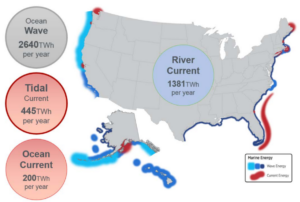What role will our oceans play in the future of renewable energy production?
Can affordable, clean, and safe power be produced in the marine environment?
How will marine renewable energy (MRE) intersect with the needs and interests of coastal and island communities?
During my 5-month internship with the hydrokinetic energy developer Verdant Power, I was able to gain a firsthand experience of how these questions are shaping the MRE industry and the debates surrounding them.
Engagement with an internship is required to complete my master’s degree in climate science and policy as a student with the Bard Center for Environmental Policy (BCEP).
How can the ocean produce energy?
Being one of the most disruptive and revolutionary energy movements taking place, MRE is the production of renewable energy through oceanic processes.

The most common forms of this technology work to harness energy from moving water through tides and waves. Key to these systems is hydrokinetic power, which compared to conventional hydropower describes the generation of energy through the natural motion of water, instead of using infrastructure to artificially increase the power potential of that flow.
In the U.S. alone, there exists an estimated MRE production potential of over 3,000 TWhs per year, enough to power over 3 million homes (Fig. 1). Although very little of this potential has been developed so far Verdant Power has pioneered the nation’s transition from resource assessment to technology deployment.
Verdant Power on the frontier of MRE
Verdant Power is a New York -based company that develops hydrokinetic turbines which generate clean electricity from the flow of freshwater rivers and oceanic tides, both for village- and utility-scale purposes. Verdant’s mission is to help build sustainable communities by promoting access to hybridized renewable energy systems.
Since 2000, Verdant has led the U.S. MRE movement by working to test and demonstrate their technologies. They stand out as one of if not the most experienced hydrokinetic and MRE developers in the U.S. After over 2 decades of experimentation, research, and development, the company successfully deployed 3 tidal power turbines in the East River of New York City (NYC) during October of 2020 (Fig. 2). So far, the system has exceeded expectations by producing 100 MWhs of energy in 85 days, and is on track to provide 430 MWhs to the NYC grid each year.

Called the Roosevelt Island Tidal Energy (RITE) project, Verdant’s new system is the first tidal power facility to operate in the U.S. As well, their plan for the East River goes beyond the deployment of turbines alone. Over the next several years, Verdant plans to transform the RITE project into a global center for MRE demonstration and public engagement.
An intern’s perspective
As an intern with Verdant, I was able to get involved in the process of deploying the RITE project’s first hydrokinetic turbine system and other international company development projects, as well as conduct research reports on economic, policy, and industrial dimensions of the hydrokinetic and MRE sector.
Being included in various areas of the company’s work has proven to be an in depth experience through which I have developed a stronger understanding of not only the MRE industry, but also the nature of how collaborative networks of actors across various institutions, disciplines, and nations function and interact to achieve common goals.
For example, one major obstacle that the MRE industry faces today is to become cost-competitive with cheaper renewable energy sources. Hence, revenue-support mechanisms must be provided by governments to allow developers to reduce market risk and uncertainty when pursuing new projects. With that risk accounted for, MRE can be deployed at a more rapid rate, and electricity costs will substantially decrease. One of my responsibilities during this internship was to research the status of these mechanisms on a global scale and submit a report of my findings to Verdant.
I recently finished my internship with the company and have since had time to reflect on my experience as well as its intersection with my first year of coursework at the BCEP.
Several observations I have noticed are:
- In context of my literature review on renewable energy access in rural areas, I’ve realized that MRE may be essential to energy security for remote island and coastal communities.
- A theoretical emphasis on the importance of interdisciplinary collaboration has been prominent in my classes at BCEP. This internship has helped me understand that such cooperation is not only valuable in academia, but that in practice interdisciplinarity plays an important role in developing holistic strategies for sustainable growth (particularly in an international arena).
- Although MRE has gained a lot of attention over the past several years, it remains absent from academic discussions of renewable energy and oceanography at Bard, at least in my experience.
- Understanding discount rating has been useful to the research I have done during this internship. Thanks to my first-year classes on environmental economics and econometrics, I was able to understand and report on the use of discount rates when comparing the levelized cost of energy (LCOE) across various MRE technologies.
